| [naar
inhoudsoverzicht muziekgeschiedenis]
[naar
inhoudsoverzicht korte biografieen]
[naar Webern-
biografie
1]
[terug naar inhoud
Webern-biografie 2]
[naar
literatuurlijst]
inhoud:
Vienna at the turn of the century
Further
reading
|
BIOGRAPHY
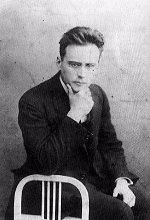
Anton von Webern
1902 - Study of musicology
Anton Friedrich Wilhelm von Webern was born in Vienna on December 3rd
1883 as son of a civil servant. Already during his school time, he
took music lessons and became acquainted with the works of leading contemporary
composers such as Richard Strauss and Gustav Mahler.
Already in 1899, he started to compose on late Romantic models,
in 1902 he began the study of musicology (professor Guido Adler) at the
University of Vienna and took his degree four years later with the publication
of Heinrich Isaak's „Choralis Constantinus II", chanting from the early
16th century.
1904 - Schönberg's student
In 1904, Webern became Arnold Schönberg's student and intensified
his compositional activity. In 1908, he composed his opus 1, the „Passacaglia"
for great orchestra which reminds od Johannes Brahms, followed by the double
canon for a cappella choir „Entflieht auf leichten Kähnen". With these
two still tonally orientated compositions Webern finished his studies with
Schönberg. But he continued - as well as his „schoolmate" Alban Berg
- to be attached to his teacher after the studies. Webern and Berg pleaded
in Vienna for the spread of the works of their teacher and did not shrink
from pointing out Schönberg's bad financial situation with collection
campaigns.
1909 - Atonality
Webern left the limits of tonality behind already early. It becomes obvious
in the lieder, which he composed after poems by Stefan George (op 3 and
4). In the „Five movements for string quartet" op 5 (1909) Webern developed
finally his aphoristic personal style, which aims with a minimal duration
of the work at the utmost preciseness of the musical expression.
Though the „Six pieces for great orchestra" op 6 (1910) are strongly
influenced by Schönberg in the form of the motif, Webern experimented
in the miniature-like „Six bagatelles for string quartet" op 9 (1913) with
new instrumentation techniques giving a melodic importance to the tone
color. Schönberg said about this „tone color melody": „What fine senses
are able to distinguish here, what highly developed spirit is able to enjoy
such subtle things!"
But Webern's personal style encountered lacks of understanding
by the public and the press. The „Five pieces for orchestra" op 10 (1913),
the longest includes 32 measures and the shortest just 7 measures, caused
a scandal at the their performance in Vienna in 1913.
1911 - Successes as conductor
Being not in a better financial position as Schönberg, Webern
was compelled to earn his living as theater conductor in Danzig, Prague,
Szczecin and Vienna among other cities. He hated this work, but did it
intermittently till 1920. In 1911, he married Wilhelmine
Mörtl. They had four children. In 1915, Webern volunteered
for the Austrian army and did his military service one and a half years,
before he was discharged at the end of 1916 for his weak sight.

Anton and Wilhelmine von Webern
(Mödling 1923)
In 1920, Webern moved to Mödling close by his teacher Arnold
Schönberg. While his works (including numerous settings to music of
poems by Rainer Maria Rilke and the „Trakl-Lieder" op 14 of 1921) did still
not find official recognition, he did make himself a name as conductor
and teacher. In addition to the performances of the „Verein für musikalische
Privataufführungen" (society for private music performances) he conducted
concerts with the Viennese Schubert choir and the choral society of Mödling.
In 1922, he started to conduct the Viennese workers' symphony concerts.
This course of concerts made it his duty - according to its name - to bring
within the reach of the masses works of the past and the present. Webern
worked for the workers' symphony concerts till 1934 and presented
there among others works by Gustav Mahler. The European music scene began
slowly to take notice of Webern at performances in Donaueschingen and London.
1924 - Dodecaphony
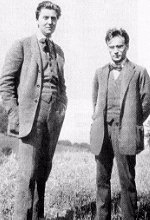
Alban Berg
and Anton von Webern
Together with Alban Berg, Webern adopted also already early the „twelve-tone
technique" developed by Schönberg. He use it for the first time in
„Drei Volkstexte" op 17 for voice, clarinet, bass clarinet and violin (1924).
Unlike Schönberg, Webern used the potentialities of the dodecaphony
for the motif, rhythmical and dynamic arrangement of his works, particularly
in the „Variations for orchestra" op 30 (1940). Webern said about the technique
in this work to develop musical events from a few motif cells: „Everything
that occurs in the piece is based on the two ideas given with the first
and second measure in contrabass and oboe."
The most important dodecaphonic compositions by Webern are the
„Symphony for a small orchestra" op 21 (1928), „Quartet for violin, clarinet,
tenor saxophone and piano" op 22 (1930), the „String trio" op 20 (1927)
and the „Concerto for nine instruments" op 24 (1934) dedicated to Arnold
Schönberg on the occasion of his 60th birthday.
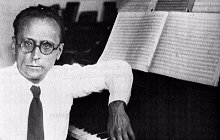
Mödling, (1930)
1933 - Inner emigration
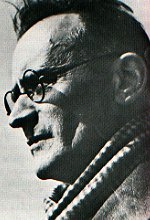
Anton von Webern (1940)
In 1933, Arnold Schönberg emigrated to America, Alban Berg
died in 1935. Anton von Webern got rapidly into a personal isolation,
aggravated by the political troubles (civil war in 1934 and corporative
state government under Dollfuß and Schuschnig) and financial difficulties
as well.
In this time, Webern met the Jone family. He was a close friend
of Hildegard Jone. The composer used her poems as texts for his three cantatas
(1st cantata „Das Augenlicht" op 26 of 1935, 2nd and 3rd cantata
op 29 and 31 of 1940 and 1943) as well as for „Drei Gesänge
aus 'Viae inviae'" op 23 (1934). After Austria's „anschluss" into the „German
Reich" in 1938, the National Socialist rulers banned Webern's performances
and publications. In the following inner emigration, he developed in ideas
numerous references between the serial technique and religious mysticism,
which find also expression in the already mentioned cantatas after texts
by Hildegard Jone.
In spring 1945, he fled from Vienna to Mittersill, where
the family of his daughter lived. Here, he fell a victim to a fatal mistake
on September 15th 1945. An American soldier took him for a smuggler
and shot him dead, as Webern smoked a cigarette outside the house after
closing time.
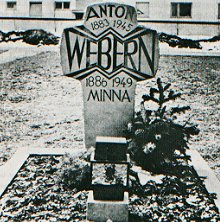
|